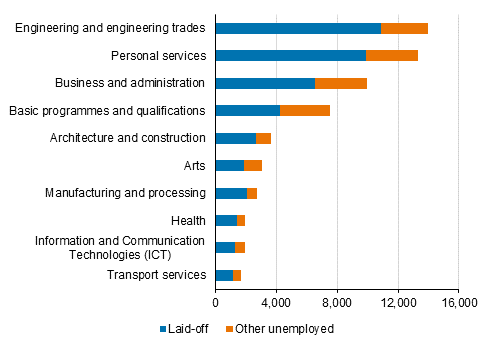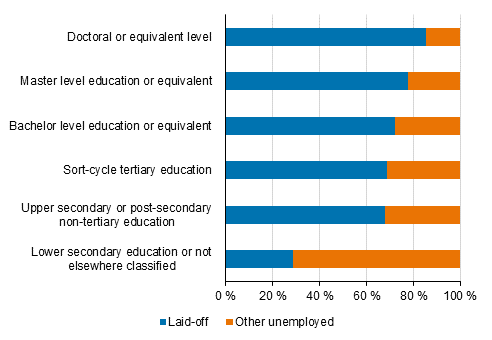Published: 28 May 2021
Majority of growth in the number of unemployed persons from lay-offs in 2020
According to Statistics Finland’s employment statistics, there were 351,600 unemployed persons at the end of 2020. The number of unemployed persons grew by 37 per cent from the previous year, of which over one half was caused by an increase in the number of laid-off persons. Examined by field of education, the number of unemployed persons grew most among those with qualifications in engineering and engineering trades, personal services, and business and administration. The growth in the number of unemployed with upper secondary or tertiary level qualifications was mainly due to lay-offs. The data on unemployment in the employment statistics are based on the data of the Register of Job Seekers of the Ministry of Economic Affairs and Employment.
Growth in the number of unemployed persons by field of education in 2020

Statistics Finland's employment statistics describe the economic activity of the population at the end of the year. In 2020, the number of unemployed job seekers was 351,600, which was 94,200 (37%) more than in 2019. Fifty-six per cent of the growth in the number of unemployed persons was caused by the increase in the number of laid-off persons 1) . The number of laid-off persons grew by 53,000 and that of other unemployed job seekers by 41,200 from the year before. One-fifth of unemployed persons were laid off (21%; 74,100 persons).
Examined by field of education, the number of unemployed persons grew in 2020 most among those with qualifications in engineering and engineering trades, personal services, and business and administration. The number of unemployed among those with qualifications in engineering and engineering trades grew by 14,000, most of which (78%) came from the increased number of laid-off persons. Unemployment grew by 13,300 for completers of qualifications in the field of personal services. Lay-offs accounted for 74 per cent of this growth. The field of education of personal services includes such as qualifications in the fields of hotels, restaurants, tourism, hairdressing and beauty care. The number of unemployed persons with qualifications in the field of business and administration grew by 10,000, of which 66 per cent was caused by the increased number of laid-off persons.
Of the unemployed, 58 per cent were men (204,000) and 42 per cent women (147,600). The number of unemployed men and women grew almost in the same proportion in 2020; that of men by 36 per cent and that of women by 37 per cent. However, women’s lay-offs increased in relative terms more than men's. The number of laid-off women grew by 541 per cent and that of men by 179 per cent. At the end of 2019, the number of laid-off women was around four times lower than that of men and at the end of 2020 just under two times lower than that of men. Of the unemployed persons with qualifications from personal services, 72 per cent were women and of those with qualifications from business and administration, 63 per cent were women, while men made up 92 per cent of unemployed persons with qualifications from engineering and engineering trades.
Share of laid-off persons in the growth of unemployment bigger in relative terms among highly educated persons
Of those unemployed at the end of 2020, altogether 76,300 (22%) had completed a tertiary level qualification and 178,900 (52%) an upper secondary level qualification. A post-comprehensive school qualification was missing or qualifications were unknown for 92,500 unemployed persons (27%). 2) In 2020, the growth in the number of unemployed persons mainly concerned those with upper secondary level qualifications; those with upper secondary level qualifications made up nearly one-half of the unemployment growth (48%; 43,700). Those with tertiary level qualifications accounted for 24 per cent of the growth (21,900) in unemployment and persons with only comprehensive school education or with unknown qualifications 3) for 27 per cent (24,700).
The growth in the number of unemployed persons with upper secondary or tertiary level qualifications was mainly due to lay-offs. Among completers of upper secondary or short-cycle tertiary education nearly 70 per cent of the growth in unemployment is explained by lay-offs and among those with tertiary level qualifications 74 per cent. The growth in the number of unemployed persons among those with different levels of university degrees differed from one another in that for those with lower university degrees, 72 per cent of the growth in unemployment was due to layoffs, for those with higher university degrees 78 per cent, and for those with doctorate level degrees 85 per cent. Lay-offs explain 29 per cent of the growth in the number of unemployed persons among those with only lower secondary education or with qualifications unknown.
Share of laid-off and other unemployed persons in unemployment growth by level of education in 2020

1) The number of laid-off persons does not take into account part-time lay-offs, nor are they counted as unemployed job seekers.
2) The educational level (highest qualification) of unemployed persons at the end of 2020 was deduced from the latest data on education from 2019. This limited the unemployed in the education level examination to those belonging to the 2019 population (in total 347,675 unemployed at the end of 2020 belonged to the 2019 population).
3) There is undercoverage in the number of qualifications attained abroad. Qualification data are missing for around one-half of persons of foreign background.
Source: Employment Statistics, Statistics Finland
Inquiries: Meri Juuti 029 551 3061, Jukka Tapio 029 551 3429, info@stat.fi
Head of Department in charge: Hannele Orjala
Publication in pdf-format (222.2 kB)
- Tables
-
Tables in databases
Pick the data you need into tables, view the data as graphs, or download the data for your use.
Appendix tables
Updated 28.05.2021
Official Statistics of Finland (OSF):
Employment [e-publication].
ISSN=2323-6825. profession and socio economic position 2020. Helsinki: Statistics Finland [referred: 8.1.2026].
Access method: http://stat.fi/til/tyokay/2020/01/tyokay_2020_01_2021-05-28_tie_001_en.html

